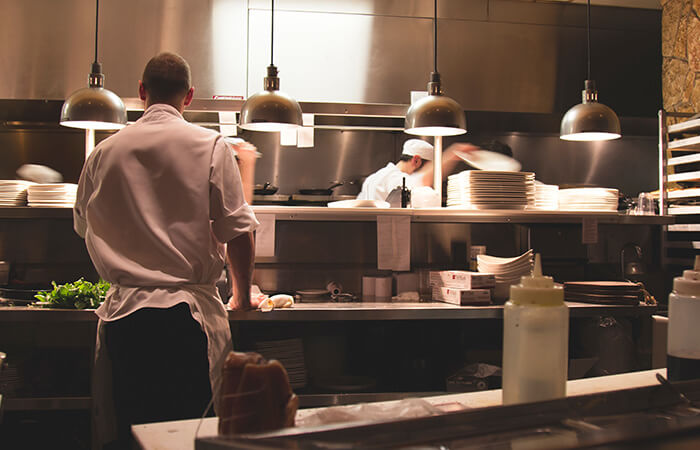
The kitchen is a dangerous workplace that exposes the chefs or kitchen workers to common kitchen injuries. These injuries include knife cuts, burns, eye irritation, chef’s foot, shattered cookware, slips and falls, and more.
Here are some of the common accidents and learn how to deal with them if in case such injuries happen to you.
7 Most Common Kitchen Injuries:
1. Knife Cuts and Lacerations
Knife cuts are the most common kitchen injuries especially for amateur or student chefs, who are still practicing the proper handling of a knife. Professional chefs are still exposed to this danger because of the tendency of their hands to slip.
Knife cuts can be dangerous even if they seem small. The ones who get lacerations are prone to infection or tetanus which is lethal. If you accidentally cut yourself, take note of when or how it happened, especially if the cut is deep.
If you get a cut, apply pressure on the area. Clean it with soap, apply an antibiotic, and cover the area with a bandage. The wound heals if properly treated, but can worsen if it gets infected.
For those with medical problems like diabetes, it is better to seek medical attention. Also, notice if there is a sensation of numbness or weakness after the accident.
Prevent knife injuries by placing knives in their appropriate areas. Learn the proper cutting method to avoid lacerations. One of the most commonly used knife skill is the bear claw, where the hand imitates the paw of a bear.
2. Slips, Trips, and Falls
Although these accidents are common to everyone, chefs and kitchen workers are the most prone to it, which is due to spills on the floor, water leaks, and the like.
It is important to eliminate the factors that can cause someone to slip on the floor. You can remove any object that can cause anyone to trip over, such as electrical cords, small packages, etc. Remove the spills at once or mop the wet floor immediately. Also, wear non-skid shoes.
If in case you do end up slipping, tripping, or falling, assess yourself immediately for injuries. For sprains and strains, treatment and prevention are discussed below.
3. Burns and Scalds
Regardless if you’re a chef or not, you might have probably encountered this injury once in your life or more. Burns and scalds are painful and ugly.
If you happen to burn or scald yourself, you must immediately move away from the heat source. Place the affected part under cool water for 20 minutes. Remember not to put ice directly on the affected area. Remove clothing or accessories on the area. If the burn is painful, pain relievers can help mitigate the pain.
Prevent burns and scalds by using the proper equipment when it comes to holding hot objects. If cooking with hot oil, lessen the strength of the burner before putting in the ingredient that needs to be cooked.
4. Eye Irritation
This injury is something almost everyone has experienced, especially if it involves cutting onions. There are also moments when you forget to wash after preparing ingredients; that you end up rubbing your eyes with your hands.
Therefore, one of the best solutions to avoid eye irritation is to wash your hands after every food preparation. Also, do your best not to rub your eyes.
If you are cutting onions, it will be helpful for you to refrigerate them first or soak them in cold iced water for a few minutes. Doing so will lessen the enzymes that cause eye irritation.
5. Sprains and Strains
These are also one of the common kitchen injuries. Both sprains and strains share the same symptoms, except that they affect the different areas of the foot. Sprain commonly affects the ligaments whereas strains affect the tendons or muscles.
You can take a pain reliever to eliminate the pain. If the area is swelling, a bandage should help, but do not wrap it tightly. You may put a block of ice on the affected area for a few minutes. It is highly advisable that you rest after the injury. Wearing non-skid shoes are prevention.
6. Chef’s Foot
It is a type of injury that pertains to all foot problems that chefs are prone to. It includes Hallux rigidus, bunions, Morton’s neuroma, and the like. The common cause of chef’s foot is due to prolonged standing and wearing ill-fitted shoes.
Eliminate any problems caused by chef’s foot by simply using your allotted breaks to sit down and rest. If your kitchen responsibility requires you to be in a stationary position, walk once in a while. When you get home, it is helpful to elevate your feet. Also, wearing comfortable non-skid shoes minimizes the risk of having a chef’s foot.
7. Shattering Cookware
Cookware may shatter due to intense heat. It may cause cuts and burns due to an explosion.
It may also cause internal injuries to those who have eaten food cooked in an already shattered cookware.
Avoid such instances from happening by making sure to read the labels that come with the cookware’s packaging. Make sure that the cookware is appropriate to the cooking method that you will be using. Never heat your oven above the temperature that cookware can endure. Most of all, do not serve food cooked in shattered cookware.
If you’re a chef, common kitchen injuries are inevitable in your line of job. You might have experienced one or more of them in your life. However, it is important to lessen the risks of such injuries from happening. As they say, prevention is always better than cure.
Sources:
FinediningLovers – 10 Chefs Shares Their Worst Kitchen Injuries
FoodNetwork – 5 Common Kitchen Accidents and How to Avoid Them








